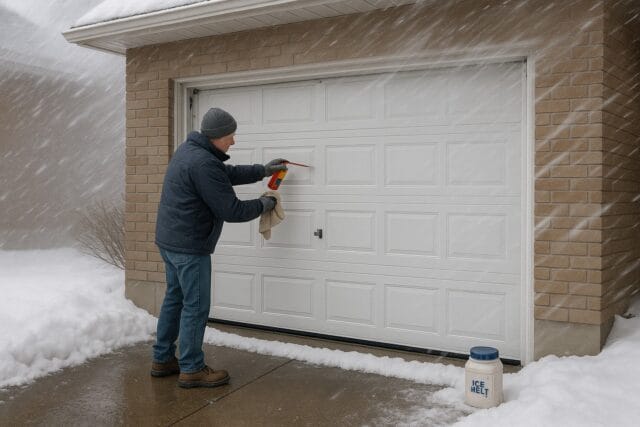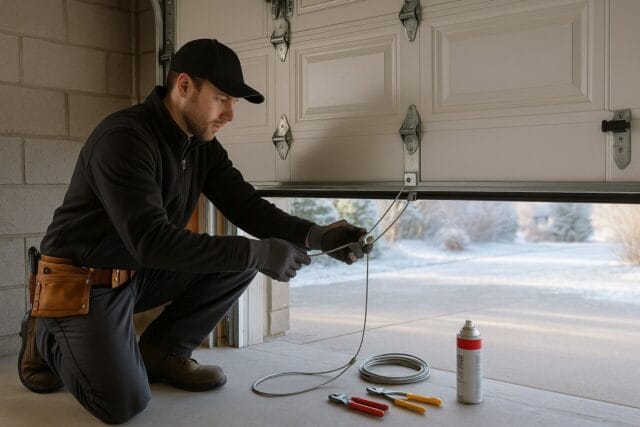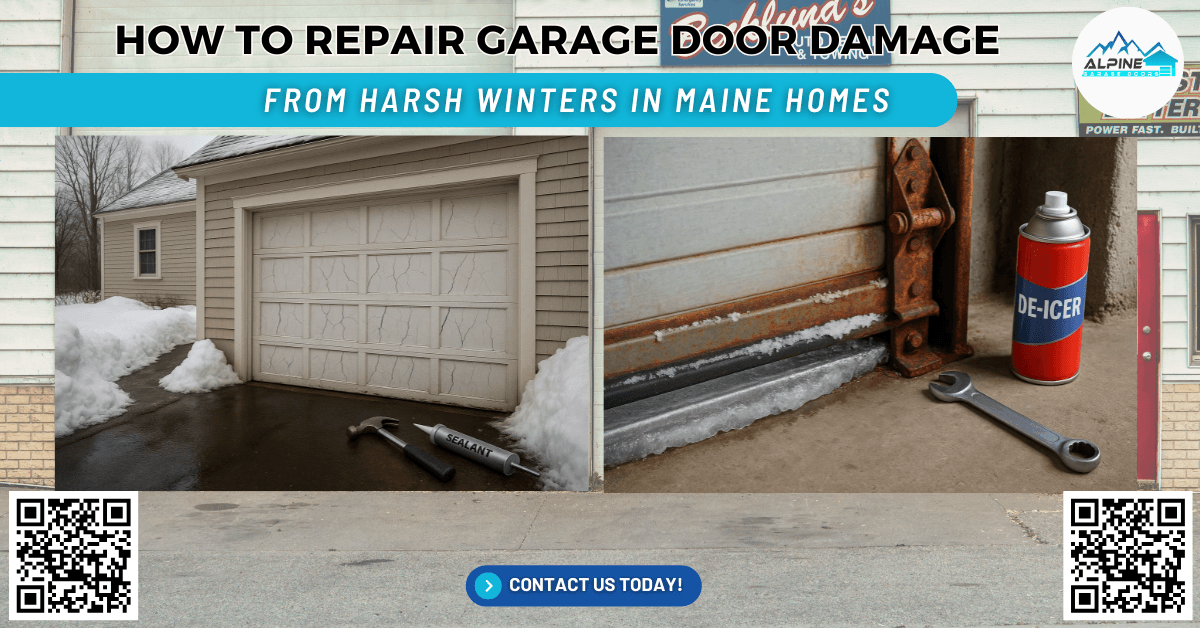Winter’s Wrath: The Maine Garage Door Dilemma
In the heart of winter, a homeowner in Bangor, Maine, faced an emergency with their garage door. After a relentless snowstorm and plummeting temperatures, her garage door froze shut. The opener strained and eventually failed, the bottom seal tore, and cold air invaded the garage, threatening her home’s energy efficiency and safety. Her situation is not rare in a region where snow accumulation can reach over 90 inches per year and temperatures regularly drop below minus 20 degrees Fahrenheit. These conditions test the durability of every garage door system in the state and frequently demand urgent service calls to repair garage door components under extreme stress.
According to the National Weather Service, Maine ranks among the snowiest states in the United States. This climate causes extreme wear and tear on mechanical systems and structural components, particularly on garage doors, which often serve as both a main entrance and insulation barrier for the home. When ice, snow, and freezing temperatures interact with the sensitive moving parts of a garage door, it can lead to issues such as broken springs, jammed tracks, warped panels, and malfunctioning openers that ultimately require professional technicians to repair garage door systems before further damage occurs.
Understanding how to effectively repair garage door systems after the harsh winters in Maine is essential for homeowners. Timely repairs and proper maintenance can prevent more costly damage, increase energy efficiency, and ensure the safety of the garage space. In this comprehensive guide, we will walk through how to identify, troubleshoot, and repair the most common winter-related garage door problems, while emphasizing preventative strategies and professional services that are practical and accessible for Maine residents.
How Winter Weather Damages Garage Doors
What Cold Weather Does to Your Garage Door System
Cold weather directly affects the functionality of garage doors. Metal components such as springs, cables, and tracks contract in freezing temperatures, increasing the likelihood of fractures and malfunctions. Springs, whether torsion or extension, may become brittle and snap under stress. This can happen suddenly, creating a dangerous situation due to the high tension stored in these components.
Rollers and hinges may freeze, especially when ice accumulates along the track or around the hardware. When the garage door opener attempts to move a frozen or jammed door, the motor experiences excessive strain. In worst-case scenarios, this results in motor burnout, a costly and avoidable repair. In many instances, homeowners may mistake the problem for a dead remote battery or faulty wiring, but the root cause often lies in components that have seized up due to the cold.
Weather stripping and insulation materials also degrade quickly in cold climates. Rubber seals can stiffen and crack, allowing cold air and moisture to seep into the garage. This not only impacts the indoor temperature but also leads to higher energy bills and potential water damage. In homes with attached garages, this can also allow cold air to infiltrate living spaces, placing extra strain on your HVAC system and reducing energy efficiency throughout the home.
Warning Signs of Winter Garage Door Damage
How to Know It Is Time for Repairs
There are several early indicators that your garage door may be suffering from winter damage. Recognizing these signs early can help you avoid costly repairs and ensure safety.
- The garage door does not open or close properly, or seems to pause during operation
- Loud noises like popping, screeching, grinding, or banging during use
- Visible cracks or gaps in the weather stripping or the bottom seal
- Uneven or jerky door movement when opening
- The door appears off-track or visibly tilted to one side
- The garage door opener remote or wall switch becomes unresponsive or delayed
- Water pooling or frost forming inside the garage near the door
- Unusual vibrations or shaking during movement
When these issues arise, it is essential to conduct a full inspection of the garage door system. Check not only the visible parts but also examine springs, pulleys, sensors, and fasteners. A good rule of thumb is to listen for unusual noises and look for irregular movement. If anything seems out of place or different from normal operation, it is likely a sign that repairs are needed.
Step-by-Step Guide to Repair Garage Door Damage
1. Clear Away Ice and Snow Buildup
Begin with a thorough inspection around the base and sides of the garage door. Ice can bond the bottom seal to the ground, and snow can block track movement. Use a plastic snow shovel and apply pet-safe de-icer or warm water in a controlled manner to loosen frozen areas. Avoid metal tools that could scratch tracks or damage the door surface.
Silicone-based lubricants are highly recommended for use on rollers, hinges, and locks to reduce friction and prevent freezing. Apply lubricant sparingly and wipe off excess to prevent dust accumulation. Be sure to use products rated for sub-zero temperatures to maintain effectiveness. If your garage floor has a slope, ensure water from melted ice does not refreeze around the seal.

Regularly removing snow buildup around the garage door and applying de-icing materials before snowstorms can help prevent issues before they start. This is especially important if your garage faces the prevailing wind direction, where snowdrifts can pile up rapidly.
2. Replace Damaged Weather Stripping and Bottom Seals
Weather stripping plays a vital role in maintaining indoor temperature and blocking moisture. If it becomes cracked or peels away, it can cause drafts and reduce your garage door’s insulation value, also known as its R-value. Replacing damaged strips is an affordable and impactful repair that provides immediate benefits.
Steps to replace a bottom seal:
- Disconnect the garage door from the opener
- Lift the door manually and secure it with locking pliers
- Slide the old weather seal out of its track
- Clean the track thoroughly with a wire brush or vacuum
- Insert the new rubber or vinyl seal and trim the edges for a snug fit
- Test the seal’s fit by slowly lowering the door and checking for light gaps
Consider investing in a commercial-grade weather stripping kit that includes top, side, and bottom seals for full perimeter protection. In colder climates like Maine, double-lip seals and threshold barriers can significantly reduce drafts and water intrusion.
3. Examine and Replace Broken Springs and Cables
Garage door springs are under extreme tension and are susceptible to sudden failure in cold climates. If you notice the door is hard to lift, slams shut, or makes sudden loud bangs, the spring may be broken. Cables may also fray or snap due to corrosion or wear.
Because high-tension components like springs and lift cables can cause injury if handled improperly, homeowners should never attempt DIY replacement unless professionally trained. Call a garage door repair technician immediately.
A professional service team will evaluate whether your system uses torsion or extension springs and recommend replacement options. Modern garage door springs last between 10,000 to 15,000 cycles, or roughly 7 to 10 years, but exposure to salt and ice in Maine may reduce this lifespan. Stainless steel or coated cables and high-cycle springs may offer longer durability in harsh conditions.
Technicians will also check pulleys, cable drums, and tension systems to ensure safe and reliable function. Routine inspections during maintenance visits can catch worn cables or springs before they fail.
4. Adjust or Replace Worn Rollers and Tracks
Rollers and tracks facilitate smooth operation, and any corrosion or warping affects door balance. If your garage door is jerking, dragging, or making grinding noises, the rollers may need replacement. Misaligned or rusted tracks can also cause doors to come off the rails entirely.
Steps to address roller issues:
- Unplug the garage door opener for safety
- Manually operate the door to feel for friction points
- Replace metal rollers with nylon-coated ones for quieter movement and better insulation
- Clean and align the tracks using a level and rubber mallet
- Tighten any bolts or lag screws that hold the track brackets in place
- Apply a silicone-based spray to reduce friction and prevent freezing
If the garage door still binds or feels off-balance, a professional may need to realign the track system or install reinforcements. This is especially important for older doors that have experienced repeated freeze-thaw cycles, which can cause subtle warping over time.
5. Troubleshoot Garage Door Opener Problems
Garage door openers experience additional strain during winter. Cold temperatures can affect motor performance and battery life, especially in openers over 10 years old. Issues like power surges, condensation, and worn drive gears are more common in cold-weather regions.
Common garage door opener problems include sensor misalignment, wiring issues, and worn gears. Begin troubleshooting by checking the safety sensors near the floor. Ensure they are clean, aligned, and unobstructed by snow or salt residue.
If the motor hums but does not lift the door, check for a broken drive gear or a disengaged emergency release cord. Replace remote batteries if needed and consider upgrading to a smart garage door opener for real-time diagnostics. These modern systems send alerts to your phone when something goes wrong and can prevent long delays in identifying issues.
Garage door openers should be installed with insulated mounting brackets in cold climates to minimize temperature-related strain. Battery backups are also recommended to maintain operation during power outages.
Preventative Maintenance Tips for Winter
1. Schedule a Pre-Winter Tune-Up
Professional garage door maintenance before the onset of winter is your best defense against breakdowns. Tune-up services include tightening screws, checking tension, lubricating moving parts, and testing sensors and auto-reverse systems. This is an ideal time to catch worn components, stretched cables, or failing openers before snow and ice cause further complications.
Having a licensed technician evaluate your system annually ensures smooth operation and prevents costly repairs during the colder months. Make this part of your seasonal home maintenance routine, just like checking your heating system and sealing your windows.
2. Insulate and Weatherproof Your Garage Door
Insulation helps regulate garage temperature and reduces heating costs. Installing a new garage door with a high R-value rating or adding insulation panels to your existing door makes a measurable difference in energy savings.
In addition to insulation, full weatherproofing with seals and threshold guards helps keep out snow, rodents, and moisture. These measures also extend the life of your garage door parts.

Insulated garage doors are particularly beneficial for homes with attached garages, as they reduce heat loss and help maintain indoor comfort levels. Consider polyurethane or polystyrene core materials when choosing a new garage door for superior performance in cold weather.
3. Monitor and Test Safety Features
Safety sensors and auto-reverse features are required by law in the United States and must work properly to prevent injury. In cold weather, sensors can become misaligned or blocked by snow.
Test the safety features monthly by placing a small object under the closing path. The door should reverse immediately upon contact. If it does not, consult a garage door repair service without delay.
You should also inspect wiring, mounting brackets, and sensor covers for signs of corrosion or ice buildup. Keep the area around the sensor clear of clutter and moisture.
4. Upgrade Older Garage Door Systems
Older systems with worn springs, noisy garage door openers, and outdated hardware may not hold up well during repeated winter exposure. Upgrading to a modern garage door system provides more reliable performance, quieter operation, and improved safety.
Smart openers allow for remote access and monitoring, providing notifications for any operational issues and offering greater peace of mind during snowstorms or vacations.
Look for garage door openers with built-in Wi-Fi, automatic lock systems, and weather-resistant features. These models are built to withstand the unique challenges faced by homeowners in northern climates like Maine.
Final Thoughts
Maine homeowners face unique challenges during the winter months, and the garage door often takes the brunt of the cold, wind, ice, and snow. Left unaddressed, small problems such as cracked seals or rusted rollers can lead to complete system failure, energy loss, and security risks.
Understanding how to repair garage door systems affected by winter conditions involves not only knowing what to look for but also acting quickly. From frozen tracks and noisy garage door rollers to broken springs and garage door opener malfunctions, winter exposes the weakest links in your garage system. By inspecting the door regularly, performing basic maintenance, and seeking expert advice, you can avoid costly repairs and ensure the safety of your family and home.
Garage doors are complex mechanical systems with many interconnected parts that require professional care. While DIY garage door repairs are possible in minor situations, high-tension components such as springs and cables, and safety features like sensors and motors, should only be handled by trained technicians.
An investment in seasonal garage door maintenance and winter readiness is an investment in your home’s longevity, energy efficiency, and safety. Do not wait until the door refuses to open on a freezing morning. Stay proactive and make winter garage door care a top priority.
How Can Alpine Garage Doors New England Help You?
Alpine Garage Doors New England is proud to serve the local garage door needs of Maine, Massachusetts, and surrounding areas. Our top-tier team of trained professionals is equipped to handle every garage door issue, from basic maintenance to full garage door replacement. With cutting-edge training and a reputation as an undisputed industry leader, we deliver top-notch garage door service with a focus on safety, efficiency, and long-term value.
Whether you are dealing with a noisy garage door, broken spring, misaligned track, or malfunctioning opener, our emergency garage door services are available when you need them most. We also provide preventative maintenance, insulation upgrades, weather stripping installation, smart garage door opener setup, and full garage door replacements.
Contact us today to schedule your winter tune-up or receive a free quote. Let our professional team help you ensure smooth operation and peace of mind all season long.
Alpine Garage Doors New England
150 Cross St, Boston, MA 02109
Phone: (617) 865-7222
Your garage door deserves expert care. Let us keep it running strong, no matter how harsh the winter may be.
Frequently Asked Questions (FAQs)
- Can garage door components expand and contract during temperature changes?
Yes, metal components like springs, tracks, and rollers naturally expand and contract with temperature fluctuations. This constant shifting can lead to misalignment, loosening of hardware, or added stress on the garage door system over time.
- How do I prevent my garage door from sticking to the ground in freezing temperatures?
To prevent sticking, apply a silicone-based spray to the bottom seal and keep the threshold area clear of snow and ice. Avoid using salt directly near the seal, as it can cause the rubber to deteriorate.
- Is it safe to use a space heater in my garage during winter if the door has gaps?
Using a space heater in a poorly sealed garage is inefficient and potentially unsafe. It is best to repair weather stripping and insulation first to retain heat and avoid fire hazards or energy waste.
- How do I know if my garage door is properly balanced in cold weather?
Disconnect the opener and lift the door manually halfway. If it stays in place without rising or falling, it is balanced; if not, it may indicate spring tension issues that require professional adjustment.

